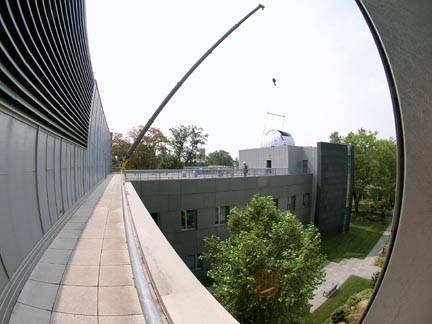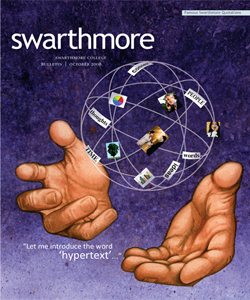New Van De Kamp Observatory
A 20-foot diameter dome for the new Peter van de Kamp Observatory was hoisted into place on Aug. 15, literally capping off the College's five-year-old Science Center. The observatory awaits the arrival of a new 24-inch reflecting telescope, set for later this fall. (Click here to view a short video of the dome being hoisted into place.)
A telescope pier and other infrastructure were included in the construction of the Science Center, which opened in 2003, but no funding was available at the time for the planned telescope and dome.
A National Science Foundation grant will provide a computerized telescope of modern design; the dome to house it was purchased after the College received an anonymous donation in honor of van de Kamp, professor of astronomy and director of the Sproul Observatory from 1937 to 1972.
The dome was assembled in a nearby parking lot and lifted into place atop the building as dozens of College faculty and staff members watched. Among them, beaming with excitement, was David Cohen, associate professor of astronomy.
Cohen says that the telescope will be used to train Swarthmore students in observational techniques—but that it would also be used to do basic research on the spectra of objects that are already being studied in other wavelengths by Cohen and his colleague Associate Professor of Astronomy Eric Jensen. The College has already purchased a sophisticated spectrograph for the new instrument.
Cohen observes X-ray emissions from massive stars using NASA’s orbiting Chandra X-ray telescope; he says that “it would be very useful to have optical spectroscopy at the same time to see what a star’s circumstellar disk is doing.” Jensen observes young stars, often using the Spitzer Infrared Space Telescope. Over time, having additional spectra could help him determine the linear space velocity of those stars, which could aid him in determining the type of system that these stars are part of.
“Not many telescopes of this size have the capability for spectroscopy that ours will, especially those at small liberal arts colleges,” says Cohen. “Eric and I hope to have students using the spectrograph not only for research projects but also as part of our department's advanced laboratory program for physics majors.”
While the new telescope is used for research and teaching, the Sproul Observatory’s 24-inch refracting telescope will continue to be used for monthly public viewing. During Alumni Weekend, visitors were able to observe Saturn and the moon, Cohen says.
 Email This Page
Email This Page
